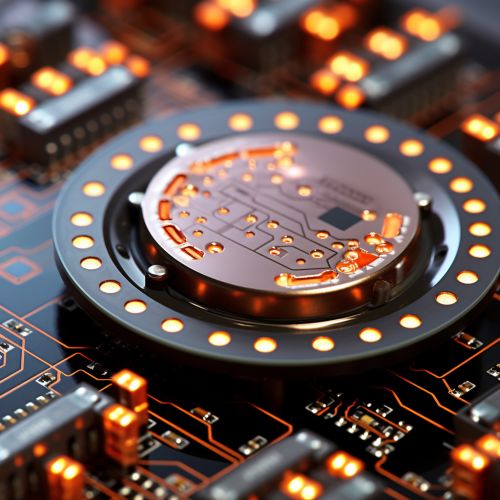Chemical Sensors
Introduction
Chemical sensors are devices that transform chemical information, ranging from the concentration of a specific sample component to total composition analysis, into an analytically useful signal. The chemical information, mentioned above, originates from a specific chemical reaction of the analyte or from a physical property of the system investigated. They can have applications in different areas such as medicine, home safety, environmental pollution and many others. Chemical reactions are usually specific and reliably reproducible, thus, chemical sensors can have high specificity and repeatability.
Classification of Chemical Sensors
Chemical sensors can be classified based on several aspects including the type of recognition system (biological or artificial), the transduction mechanism used (optical, piezoelectric, electrochemical, etc.), and the target analyte (ions, molecules, etc.).
Based on Recognition Element
Chemical sensors can be broadly divided into two categories based on the recognition element used: biological and artificial. Biological sensors, also known as biosensors, utilize a biological recognition element such as enzymes, antibodies, or whole cells. Artificial sensors, on the other hand, use an artificial recognition element, which could be a molecularly imprinted polymer, a synthetic receptor, or a nanoparticle-based system.
Based on Transduction Mechanism
Chemical sensors can also be classified based on the transduction mechanism used to convert the chemical signal into an electrical signal. This includes optical sensors, piezoelectric sensors, electrochemical sensors, and others. Optical sensors rely on changes in absorbance, fluorescence, or refractive index to detect the presence of the target analyte. Piezoelectric sensors detect changes in mass or force, while electrochemical sensors measure changes in electrical properties such as conductivity, potential, or current.
Based on Target Analyte
Chemical sensors can be designed to detect specific ions, molecules, or other analytes. For example, ion-selective sensors are designed to detect specific ions in solution, while gas sensors are used to detect specific gases in the atmosphere. Similarly, biosensors can be designed to detect specific biomolecules such as glucose, cholesterol, or specific pathogens.


Working Principle of Chemical Sensors
The working principle of a chemical sensor involves two primary stages: recognition and transduction. In the recognition stage, the sensor interacts with the analyte to produce a chemical or physical change. This change is then converted into an electrical signal by the transducer. The magnitude of this signal is usually proportional to the concentration of the analyte in the sample.
Recognition Stage
In the recognition stage, the sensor surface interacts with the analyte. This interaction can be a chemical reaction, adsorption, or a physical change such as a change in mass or volume. The nature of this interaction depends on the type of sensor and the target analyte. For example, in an enzyme-based biosensor, the recognition stage involves a specific enzymatic reaction, while in a gas sensor, it might involve adsorption of the gas molecules onto the sensor surface.
Transduction Stage
In the transduction stage, the change resulting from the recognition stage is converted into an electrical signal. This can involve various mechanisms such as changes in resistance, capacitance, mass, optical properties, etc. The transducer is usually connected to an electronic circuit that amplifies and processes the signal to provide a readable output.
Applications of Chemical Sensors
Chemical sensors find applications in a wide range of fields due to their ability to detect specific analytes with high sensitivity and selectivity. Some of the key application areas include medical diagnostics, environmental monitoring, industrial process control, and defense and security.
Medical Diagnostics
In medical diagnostics, chemical sensors are used to detect specific biomarkers in body fluids for the diagnosis of various diseases. For example, glucose sensors are used for monitoring blood glucose levels in diabetic patients, while cholesterol sensors can be used for monitoring cholesterol levels in blood.
Environmental Monitoring
Chemical sensors play a crucial role in environmental monitoring where they are used to detect pollutants and other harmful substances in air, water, and soil. For example, gas sensors are used to monitor air quality by detecting pollutants such as carbon monoxide, nitrogen dioxide, and sulfur dioxide.
Industrial Process Control
In industrial process control, chemical sensors are used to monitor and control the chemical composition of the process stream. This can help in optimizing the process, improving product quality, and ensuring safety.
Defense and Security
Chemical sensors are also used in defense and security applications for the detection of chemical warfare agents and explosives. For example, nerve gas sensors can detect the presence of nerve gases such as sarin and VX, while explosive sensors can detect substances such as TNT and RDX.
Future Trends in Chemical Sensors
With advancements in technology, the field of chemical sensors is expected to witness significant growth in the coming years. Some of the key trends include the development of nanotechnology-based sensors, wireless sensor networks, and smart sensors.
Nanotechnology-Based Sensors
Nanotechnology has the potential to significantly improve the performance of chemical sensors. Nanomaterials such as nanoparticles, nanotubes, and nanowires can provide high surface area to volume ratio, which can enhance the sensitivity of the sensors. Moreover, nanomaterials can also provide unique optical, electrical, and magnetic properties, which can be exploited for sensor design.
Wireless Sensor Networks
Wireless sensor networks consist of a large number of sensor nodes that can communicate with each other wirelessly. These networks can provide real-time monitoring of large areas, making them ideal for applications such as environmental monitoring and industrial process control.
Smart Sensors
Smart sensors are sensors that can process the signal at the sensor level and provide advanced features such as self-calibration, self-diagnosis, and communication capabilities. These sensors can provide more reliable and accurate data, making them suitable for critical applications such as medical diagnostics and defense.
